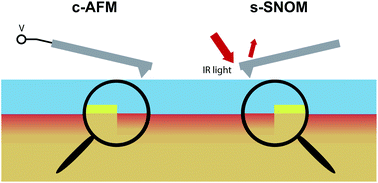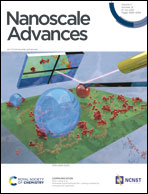Local inhomogeneities resolved by scanning probe techniques and their impact on local 2DEG formation in oxide heterostructures†
Abstract
Lateral inhomogeneities in the formation of two-dimensional electron gases (2DEG) directly influence their electronic properties. Understanding their origin is an important factor for fundamental interpretations, as well as high quality devices. Here, we studied the local formation of the buried 2DEG at LaAlO3/SrTiO3 (LAO/STO) interfaces grown on STO (100) single crystals with partial TiO2 termination, utilizing in situ conductive atomic force microscopy (c-AFM) and scattering-type scanning near-field optical microscopy (s-SNOM). Using substrates with different degrees of chemical surface termination, we can link the resulting interface chemistry to an inhomogeneous 2DEG formation. In conductivity maps recorded by c-AFM, a significant lack of conductivity is observed at topographic features, indicative of a local SrO/AlO2 interface stacking order, while significant local conductivity can be probed in regions showing TiO2/LaO interface stacking order. These results could be corroborated by s-SNOM, showing a similar contrast distribution in the optical signal which can be linked to the local electronic properties of the material. The results are further complemented by low-temperature conductivity measurements, which show an increasing residual resistance at 5 K with increasing portion of insulating SrO-terminated areas. Therefore, we can correlate the macroscopic electrical behavior of our samples to their nanoscopic structure. Using proper parameters, 2DEG mapping can be carried out without any visible alteration of sample properties, proving c-AFM and s-SNOM to be viable and destruction-free techniques for the identification of local 2DEG formation. Furthermore, applying c-AFM and s-SNOM in this manner opens the exciting prospect to link macroscopic low-temperature transport to its nanoscopic origin.



 Please wait while we load your content...
Please wait while we load your content...